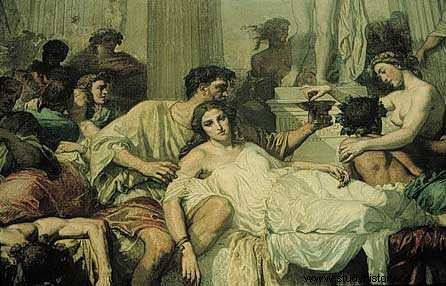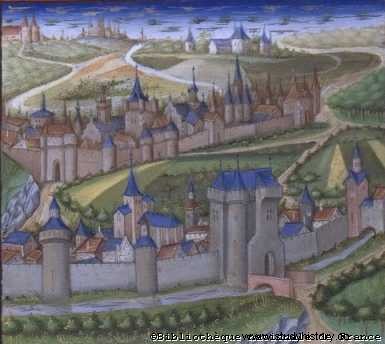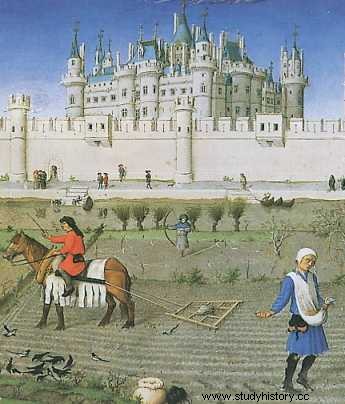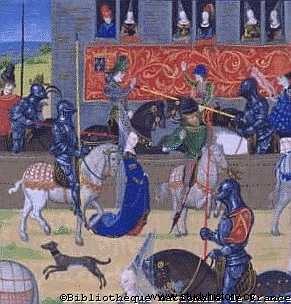Historical context
The end of a world
Shortly after the barbarian invasions, the urban decor of Rome disappeared, giving way to fields, pastures and forests. The principles of the urban culture of the Romans thus had to adapt to this new change. Powerful Germanic tribes invaded Europe and settled there in the 3rd and 4th centuries CE. They brought new rules of conduct, new codes of ethics and a new way of accumulating and distributing wealth.
The Decline of the Empire
Detail of a painting representing a Roman orgy, a sign of the decline of the Empire.

The Romans of decadence - by Thomas COUTURE (Musée d'Orsay)
A chaotic society
The world had entered a new era filled with puzzles and mysteries, it was dangerous to venture into the hostile forests where the bandits had control. Travelers from the time of the Romans had disappeared. Collective fear reigned everywhere. The early Merovingians, busy destroying themselves, did little to improve this chaotic situation. As soon as the invasions from the East had been dammed up, it was necessary to face the Vikings and Normans. The great Charlemagne partially restored the situation by laying down the principles of a new administration. The currency circulated again, schools were created, the population became hierarchical often resulting in the possession of privileges for some in relation to others. This period is commonly called:"The Little Renaissance".
The feudal organization
Local administration
Under the Carolingian Empire, the emperor represented the heart of the administrative organization. The extent of its territory had forced it to delegate its power to officials of regions, countries or districts. The insecurity of the territory was such that the kingdom was geographically delimited so that one could go from one point to another in a day on horseback. Rivers or forests delimited the regions thus formed. Necessity and fear had imposed such a network of relations between the person in charge of a region, called a vassal, and the emperor or the king to whom he had sworn loyalty. The vassal took an oath to the lord, he thus occupied a fief, a land domain of significant size. He had to provide soldiers to the lord and ensured him income. In return, the lord protected him with his army.
The organization of the fief
Certain fields and villages depend directly on the vassal who is entrenched in the fortified castle. This one entrusted hamlets to sub-vassals who in turn protect sub-vassals who take care of some plots and houses.

(National Library of France)
Decentralization of power
The feudal system is therefore made up of a set of personal relationships, based on reciprocal aid which organizes society on new bases. A certain balance of power is characteristic of the feudal system. The powerful need faithful men to help him administer the lands and the army. On the other hand, there are the less powerful who ask for help and assistance, thus becoming servants of the most powerful. But they will also be able to promulgate laws, recruit soldiers... The feudal system was born of the weakness of States and the insecurity it engendered. The state was subsequently fragmented into a large number of autonomous units and accompanied by the displacement of social and economic life towards the countryside as well as towards the residence of the lord:the castle.
Life at the castle
The castle was the center of a living ensemble practically in a closed circuit. It includes the dwellings of the lord, the soldiers, the free peasants, the craftsmen, the serfs as well as all that was necessary for their life:the stables, the warehouses, the stores, the ovens, the workshops... In situations exceptional features such as a seat, he could do without the outside world.

(National Library of France)
A new society
The vassal was not the real owner of his fief, it was up to the suzerain, but he could administer and use the resources and products of the land for his benefit. On the death of the vassal, the land returned to the suzerain, but in practice the son of the vassal came to renew the oath of loyalty made by his father. The vassal can himself be assisted by other people who take an oath to him, these people then received a castle, a fortified tower with a village, fields, or a road and a bridge. They were the rear vassals. At that time there were already three orders:the nobility who took care of commanding and fighting, the clergy who prayed for spiritual peace, the peasants for their part worked and harvested, they survived above all.
The emergence of nobility
On the death of Charlemagne, the imperial power weakened, the delegates of power took on independence and importance. A nobility emerged and ranked respectively into barons, viscounts, counts, marquises, dukes and princes. It even happened that vassals were richer than their lords. Thus the dukes of Normandy who controlled England were more powerful than the kings of France. When the Capetians ascended the throne their power was very limited, they did not control the whole kingdom but only the region of Île de France. They also had to ensure their heredity, but little by little the Capetians succeeded in restoring royal authority and strengthening their power. For its part, the Church recovered the spiritual monopoly of the West where the Manichean vision of the Devil and God has never been so strong.
The vassal's oath to the lord
“Everyone knows that I have nothing to feed and clothe me. It is for this, my lord, that I have asked for your mercy, and you were good enough to grant it to me, the favor of placing me under your protection. I do this on the condition that you give me enough to live on, in exchange for my services... As long as I live, and although I remain free, I will serve you faithfully. But in exchange, I will remain all my life under your power and your protection. »

Chronicles of Jean Froissard, 15th century, (National Library of France)
Expansion of the feudal system
The Carolingian Empire was at the origin of an artistic renaissance, which collapsed under the Norman invasions. However the Normans adopted the feudal system, they even exported it to Sicily and England. The feudal system was even employed in Spain by the Muslims. The Crusades exported it to the Latin lordships of the East. In the 12th century, the fiefs were the most important in the North and in the Center of Europe. They were to give rise to modern regions and major states. The feudal system remained in place for nearly half a millennium. For centuries, European regions lived in a climate of peace and prosperity, this did not exclude wars between barons, but the people rarely had to suffer plunder and plunder.
The hierarchy of nobility
- Prince
- Duke
- Marquis
- Count
- Viscount
- Baron
- Knight
- Squire
The condition of the poor
Different conditions for the people
- The artisans :They are the most privileged, they took care of working iron, copper, wood, wool... They obtained a workshop and a house by a lord and had to make tools for him in return (weapons in general ). But they remained free men.
- The Alleutiers :Among the farmers who cultivated the fields of the lord, many were those who were also free. It was the alleutiers who owned an alleu (free land without the control of a lord). They needed protection, however, and thus demanded the support of an army from a lord. In exchange, they provided the suzerain with part of the harvest and had to perform drudgery (free work):repairing a castle wall, building a bridge, harvesting... They also had to pay a tax to use the oven or the seigniorial bridge. But despite these heavy burdens, the result was an agreement between free men.
- Serfs :Much more modest than the others, they were attached to land and to a lord, so they were not free, but they lived in much less harsh conditions than one might think. This “servitude” brought them security and a certain stability.
Tilling the land in October

Jean and Herman The very rich Hours of the Duke of Berry, the month of October - by Paul LIMBOURG (Condé museum, Chantilly)
The rural world
Rurality is the nerve of the system, it constitutes the basis of economic survival. Industries are indeed not very present, they were reduced to the manufacture of weapons, fortresses, cathedrals... And interregional trade barely existed. The majority of peasants remain free men at home, slavery was limited to the royal court and vassalage. The peasants sowed by hand and used oxen to cultivate. Each year, land was left fallow (uncultivated) to make it fertile. But very quickly, the peasant's conditions deteriorated. The weather became wetter and colder in the 13th century, the harvests were bad. Soon, there was no longer enough sun to extract the salt from the sea water, the meat could no longer be preserved. Thus, diseases appeared:typhoid, dysentery and the plague, they added to the famine which pushed some people to eat dogs, cats and even their own children.
Knights
Chivalry
Breaking with the Frankish tradition of dividing the kingdom between sons, the feudal lord made his eldest son the sole heir to the fief. The other sons received a sum of money, armour, a horse trained for battle, a squire and a sword. Armed with this baggage, they ventured on the roads, and with the help of God and their sword could they conquer a fief. They were the first knights. It was under the influence of the Church that the knighthood was created, a military and almost religious order, difficult to enter. Its members were to pledge themselves to serve good, justice and honor.
Knight during a tournament

The knight's initiation
Only the sons of nobles could become knights. Rare exceptions were made for "knights of the sword" who earned this title for their courage on the battlefield. But the postulant had to follow a long apprenticeship. From the age of seven or eight, the youngest became a page and served the lord as a noble servant. At fourteen, he became a squire , he wore his shield (shield representing the coat of arms), he became his assistant on the battlefield. He learned at the same time, the handling of weapons and to mount the horse while carrying his shield and his heavy spear. He practiced dodging blows with the quintaine (wooden dummy that rotated on an axis). The instruction lasted seven years in general.
The knight's investiture
The knight's investiture ceremony traditionally took place on Ascension Day (forty days after Easter). The lord provided the knight's expensive equipment. The day before the ceremony, the postulant wore a white shirt and a red tunic, the color of blood. At nightfall, the knight spent the night kneeling before the altar of the chapel in prayer. At dawn, a trumpet sound announced the start of the ceremony. During the mass, the chaplain recalled the duties of the knight. After communion, the horse of the future knight entered the chapel. Then, with his hand outstretched above the Gospel, the young man solemnly swore to respect the rules of chivalry. He then put on his armor (hauberk, cuirass, armbands, leggings). Then the lord struck with the flat of the sword, the shoulders and the head of the knight (doubt). The lord then pronounced these words:"In the name of God, Saint Michael and Saint George, I make you a knight. Be brave, loyal, generous. » The knight would put on his helmet, seize his spear and jump on horseback. This ride was the symbol of his wandering through the world where he will have to uphold justice, defend the faith...
The knight's dub

